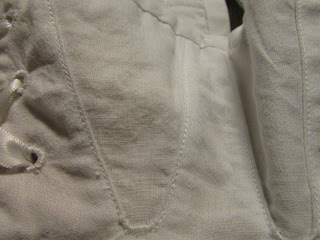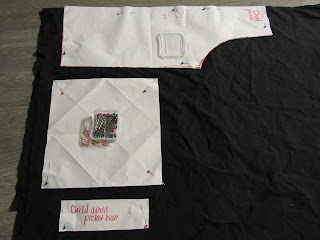The Regency Pelisse: An Unlikely Cure
"The Muslin disease"- a strain of French influenza that ravaged fashion-conscious ladies in the winter of 1803.
The first casualties of the Napoleonic Wars were not the only deaths attributed to the French in the early Regency. Where thick layers of cotton and fine wool once adorned the legs of upper-class women, now rested gauze and muslins thin enough to see through. Fashions evolved from the comparatively modest styles of Georgian England into those of the new century- the Regency Era. Ladies who embraced these new styles were known as the "Merveilleuses", or "Marvelous Women", for their daring advance into the resurgence of the Grecian Silhouette, the columnar figure, and homage to the Chemise a la Reine. They left their necks and ankles uncovered, throwing off the weighty, past century in a literal sense. This was, until winter came. Until it became impossible to ignore those same necks and ankles, now frostbitten, causing death where medicine of the time could not heal. The aristocracy was losing its most notable members to what was essentially death by fashion. Thus, the entrance of an unlikely cure- the Regency pelisse.

Painting by Louis-Leopold Boilly depicting a woman making the sign of the cross to ward off a man who believes her to be a prostitute because of her uncovered legs
The Evolution of a Coat
The
pelisse, as it was known in the Regency era, was a long coat made to resemble
the figure of the dresses fashionable at the time. Long, and molded to the dress underneath, the pelisse was both
fashionable and practical. Ladies could venture into cold winds without fear of
frostbite or the sidelong glance of a fashion critic. As was characteristic of the earlier
years of the Regency era, they began simply with little-to-no decoration,
reaching hip or knee-length with an open front, and became progressively more
elaborate as they changed to suit the styles of the later end of the era, lengthening
to the ankles with inventive trim and front-closures. The shorter style of
pelisse is referenced in periodicals of the time as a “cassock coat” or “demi
pelisse”. This is an interesting detail, considering the pre-existence of the term "cassock coat" as a men's garment.
Although they grew increasingly popular during the Regency, the origins of the pelisse may be traced back to the 15th century, following the assembly of the Hungarian Hussar regiment, a "Light calvary unit" (Britannica, 2021). This early pelisse, or, dolman, was a "fitted jacket decorated with braids." This jacket is most notably associated with the trimmings on the Regency pelisse, which were inspired by those braids, called frogging.
The pelisses of
the later end of the Regency Era are by far the most interesting in terms of
fabric choices and embellishments. Early pelisses tended to be simple, as
previously mentioned, made of cotton or muslins in contrasting colors to the
fashionable pastels of the dresses, with modest amounts of lace or fur edging. Those
of the last five years of the Regency, however, incorporated embellishments
such as rouleaux trim, swansdown, frogging, padding at the hem, and innovative
sleeve caps, among others. Ackermann’s Repository of the Arts, a British
periodical published from 1809 to 1829, offers insights into the popularity of
these fashions, saying “Pelisses are with us at
present the order of the day; one sees scarcely anything else in our
promenades,” and “The extraordinary variety both in the form and color of
head-dresses, prevents the tiresome uniformity which would otherwise result
from the general adoption of this fashion” (Ackermann, 1818). Skirts, by the
end of the Regency, were gored to support an A-line shape and padded at the hem
with scraps of fabric in order to keep it.
Rouleaux trim is
a favorite of mine. Creating intricate designs, oftentimes floral, thin fabric
tubes were stitched in symmetrical patterns across the bodice or “corsage” of
the coat, the bottom of its sleeves, and down the front adjacent to its
closures. According to
Ackermann’s, rouleaux was commonly made of either the pelisse fabric or a crape
for lessened bulk.
Frogging, a military inspired trim, could be
composed of rouleaux arranged in a military-reminiscent pattern, cording, or
braid. Sleeve caps, called epaulettes, were no less ornate, also having roots
in military clothing.
Series two,
volume 5 of Ackermann’s Repository lists fashionable fabrics for pelisse
construction at the time of its publication in 1818. “The materials of which they [pelisses] are composed are fine merino
cloth, levantine, and sometimes velvet: the latter, however, is but partially
worn. Rose-color, azure, and drab are the favorite colors.” Merino
cloth is made of wool, and levantine is a silk that originated in France. Linings,
it notes, are often of “sarsnet,” which is an old spelling of the modern sarsenet,
a fine silk. The
most interesting pelisse fabric I have been able to find mention of is “the
wool of seal skin.” “The most elegant novelty for
the carriage costume, and which is also very appropriate to the dress
promenade, is a pelisse composed, we believe, of the wool of seal skin and
lined with white sarsnet.” (Ackermann, 1817).
A Death in Court
On November 7th, 1817, Princess
Charlotte of Wales died. She was the daughter of King George the Fourth, Prince Regent, and the court declared a nation-wide mourning period, ordering “The ladies to wear…plain muslins or long lawn crape hoods.” Pelisses fashionable around this time were made from
black cloth, as befitted a Regency mourner. As was dictated by tradition, embellishments
were not permitted until a later stage of mourning. This was especially
disliked by the manufacturers of these embellishments. Kate Williams expounds
on this in her book, Becoming Queen Victoria: “Grief
was so severe, indeed, that manufacturers of silk, ribbons, and other fancy
items of dress petitioned the government to reduce the period of mourning.” Ackermann’s recounts: “The
mourning garb of our fair votaries of fashion has experienced little alteration
since the publication of our last number. In the promenade costume, pelisses
composed of black cloth, lined with black sarsnet, and trimmed with black
crape, are most in favor. There is nothing novel or striking either in the form
or trimming of these pelisses” (Ackermann, 1818).
The Pelisse as Mentioned in the Novels of Jane Austen Only two of Jane Austen’s novels mention the
pelisse (at least that I could find). Those novels are Persuasion and
Northanger Abbey. Though published together in 1817 after her death, these
novels were first completed at very different times in the Regency. Northanger
Abbey was written in 1803, and Persuasion was finished sometime between 1815
and 1816. Northanger Abbey references what would have been an early pelisse, describing
the loss of words Mrs. Allen encountered after meeting an old friend in the
street: “Mrs. Allen had no similar information to give, no similar triumphs to
press on the unwilling and unbelieving ear of her friend, and was forced to sit
and appear to listen to all these material effusions, consoling herself,
however, with the discovery, which her keen eye soon made, that the lace on
Mrs. Thorpe’s pelisse was not half so handsome as that on her own”
Persuasion, similarly, mentions the garment in
passing: “If I thought it would not tempt her to go
out in sharp winds, and grow coarse, I would have sent her a new hat and
pelisse.” (Sir Walter speaks of the ailing Mary Musgrove). This
quote calls attention to the popularity of the pelisse as a protective garment
in cold weather. Another quote from Persuasion reinforces this idea: “’I had no more discoveries to make than you would have as to
the fashion and strength of any old pelisse, which you had seen lent about
among half your acquaintance ever since you could remember, and which at last,
on some very wet day, is lent to yourself’” (Captain Wentworth speaks
of a ship he was given).
The Pelisse as Worn by Austen Herself
In
2015, Hilary Davidson, expert on Regency fashion and author of several
publications including Dress in the Age of Jane Austen, published a twenty-six-page
paper detailing her experience reconstructing a pelisse supposed to be that of Jane
Austen herself. An extremely detailed and thorough exploration of the garment,
I would highly recommend reading it in full. Belonging to a museum in
Hampshire, the pelisse, made of brown silk, is the only garment traceable to
Austen. Davidson first generalizes her own research on the pelisse by saying: “A pelisse as Austen would have understood it was a style of
coat-dress or over-garment, made in every kind and weight of fabric, from sheer
cottoned muslins to fur-lined luxury, worn indoors and out, in all seasons, and
reaching anywhere from the wearer’s knees to her ankles.” Other
definitions, she insists, do not do justice to its many variations. Referring
to construction, she notes: “they could be cut with
a separate skirt piece, like gowns, or flow uninterrupted from shoulder to hem.
Some pelisses had cutaway fronts revealing the skirt below.”
Davidson cites letters written by
relations of Austen to prove its origins, taking care to also analyze the
financial circumstances of the author at the time such expensive silk would
have been purchased. She notes: “Austen would have
made some money from her writing at this point; the pelisse could have been a
sartorial indulgence. At any rate, it is dated to the period when for the first
time she has some independent means.” The
fabric of the pelisse is described as a: “warm brown
silk twill woven with a pale gold or straw-colored oak leaf motif in opposing
diagonals containing four leaves per 4-inch repeat.” The oak leaf
motif, she says, was popular at the time, made to symbolize the strength of the
British Navy during the Napoleonic Wars, appearing in the funeral garb at those
of Britain’s most celebrated military commanders. Austen’s own brothers would
have been in the Navy at the time the garment was constructed (Davidson, 2015). Indeed, military
inspiration wove its way into everything from fashions to fabric.
The pelisse has a
wrap-front, requiring a belt to hold it closed. It has no waist seam, again utilizing
the belt to emphasize the figure of the dress that would have appeared
underneath. Though the original garment did not, by the time of its
acquisition, possess a belt, the reproduction incorporates this detail as the
most sensible closure given evidence of this practice in both fashion plates
and extant garments. It is striking to note that, as an item presumed to have been worn by Austen herself, it more accurately paints an idea of her appearance than any painting we may speculate over. Again, I would encourage reading the paper itself in full (A link will be provided in the bibliography).
End Notes
If there have been any mistakes made either in the factual or citations portions of this post, please do not hesitate to comment below and let me know. I do not wish to spread misinformation or withhold credit where it is due. Happy researching!!!!
Bibliography
1. A Beginner's Guide to Regency Fashion- Enchanted Rose Costumes
2. Reconstructing Jane Austen's Silk Pelisse 1812-1814- Hilary Davidson
3. Hussar | Soldier- Encyclopedia Britannica
4. Pelisse - Fashion, Costume, and Culture: Clothing, Headwear, Body Decorations, and Footwear through the Ages- Encyclopedia of Fashion
5. Spencers, Shawls, Pelisses and More- Kathy Hummel, Jane Austen Centre
6. How to find Ackermann's Repository of Arts online- Rachel Knowles
7. Pelisse | Fashion History Timeline- Kenna Libes
8. Fashion History: Early 19th Century Regency and Romantic Styles for Women- Dolores Monet
9. Candlestick- Art of Mourning- Barbara Robbins
10. Frogging- Joseph Pollard
11. Merveilleuses- Jane Austen's World- Jane Austen's World



















































